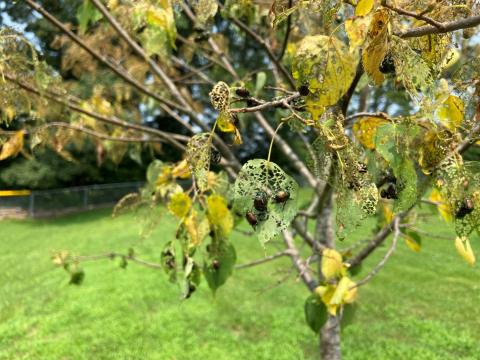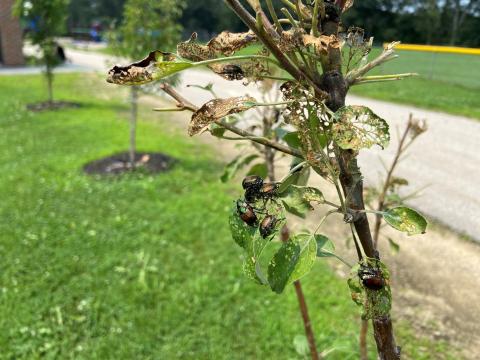Beetles Ate My Tree

When I was a child, my family grew Concord grapes. Some years, Japanese beetles (Popillia japonica) would feed heavily on the foliage. I have vague recollection of my parents trying to deal with the pest. The vines are gone now, and I had not thought much about Japanese beetles – except as an occasional nuisance – for many years. So, I was caught off guard when I recently received a phone call from my colleagues – Liz McKinley and A.J. Dupere, both with the NH Division of Forests and Lands – alerting me that two trees we had planted as part of the 2023 Schoolyard Canopy Enhancement Program had been completely defoliated as the result of heavy feeding by the beetle.
Since arriving in the United States in the early twentieth century, Japanese beetles have spread into most states east of the Mississippi River (and into some of the Great Plains states, too). In New Hampshire, the metallic-green and bronze-colored beetles emerge from the soil in late June or July and search out host plants. When preferred food sources are located, massive numbers of beetles may suddenly converge on host plants. The voracious beetles eat the tissue between leaf veins leaving a lace-like or “skeletonized” appearance. As luck would have it, linden (Tilia spp.) and apple (Malus spp.) trees – the very species we recently planted – rank among the beetle’s preferred foods. They also feed heavily on a nearby river birch (Betula nigra).

Since it had been a month since I last checked on the trees, there was little I could do to combat the infestation. If I had been more diligent, I would have tried handpicking (and dispatching in a bucket of soapy water) the beetles when the infestation was just beginning. There are other control options, including pheromone traps and insecticides; however, they must be used with caution. Pheromone traps may simply lure additional beetles and exacerbate the problem. In the meantime, we will continue watering the trees and hope that they recover. If not, we will replace them with trees that are seldom damaged by the beetle.
To learn more about controlling Japanese beetles on your property, consult UNH Extension’s Beetles on Ornamental Plants fact sheet or talk with your county forester.

Have a question about your woods? Contact your Extension County Forester today!
Do you love learning about stuff like this? Subscribe to the NH Woods & Wildlife Newsletter.
A quarterly newsletter providing private woodlot owners in New Hampshire with woodlot management news, pest updates, resources, and more.
